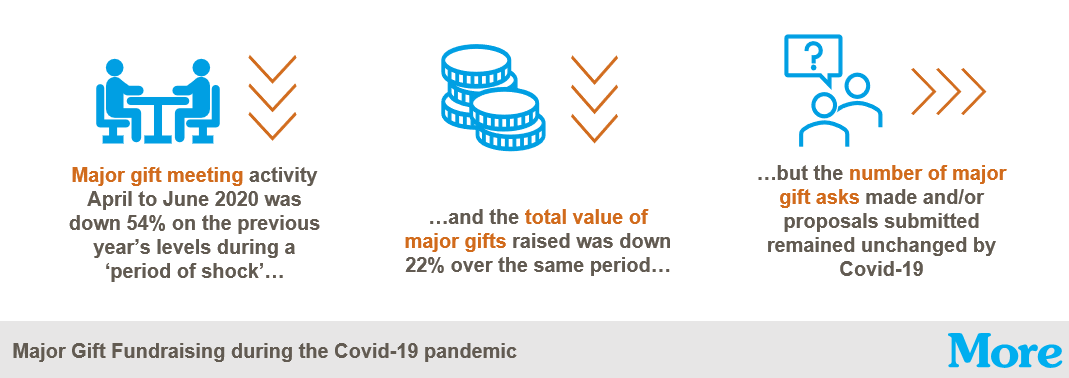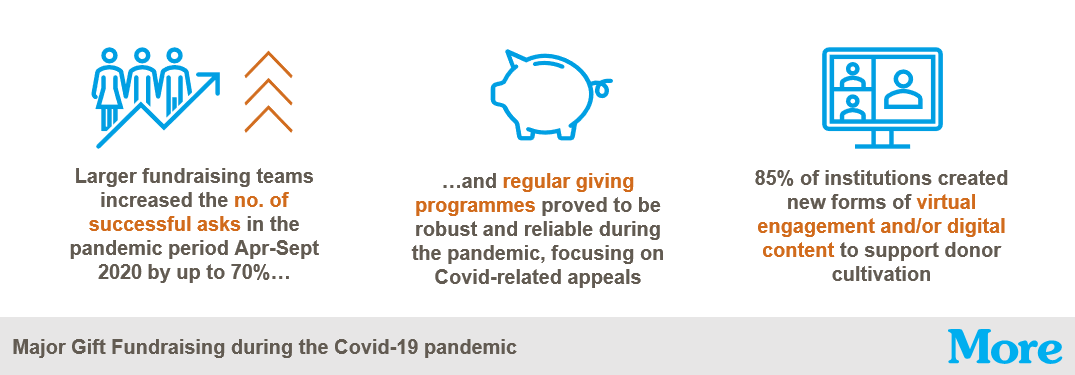
Opinion
How did major giving in UK higher education fare through the pandemic?
by Siôn Lutley - 22 April 2021

Opinion
How did major giving in UK higher education fare through the pandemic?
by Siôn Lutley - 22 April 2021
Siôn Lutley reports back on More’s recent survey of UK universities, and poses some questions for major gift fundraisers.
In early 2020, the Covid-19 pandemic disrupted life as we knew it. However, philanthropy did not stop and neither did fundraising activity – at least not for the majority. To better understand the impact of the pandemic on major giving in UK higher education, More Partnership undertook a survey of universities and Oxbridge colleges. We also hosted a special webinar to share our findings and seek further insight from 20 fundraisers leading major gifts teams at UK and Irish universities.
My More colleague and insight expert, Paul Weighand, sifted through 19 months of data from 10 universities and four Oxbridge colleges, including a full year of ‘business as usual’ activity before COVID hit, as well as the first seven months of lockdown. We wanted to see how some of the measurable aspects of major and principal gift work, such as income raised, meetings with prospects, discovery activity, and asks, had been affected and what lessons we could draw. Some findings were to be expected – but certainly not all.
We split survey participants into three: Group A – Golden Triangle universities (i.e. those with the largest advancement teams); Group B – other UK universities (the majority of them Russell Group); and Group C – Oxbridge colleges.
What we discovered
There was an understandable shock at the outset of the pandemic in March 2020, with a significant dip in meeting activity as institutions took stock and switched to home-working. Some institutions effectively ceased fundraising, either with staff on furlough or as a result of vacant posts left unfilled because of recruitment or budget freezes. The extent of this decline varied significantly: one institution in the final stages of a campaign saw only an 8% fall in meeting requests with a corresponding 2% fall in major gift meetings, while others saw meeting numbers decline by up to 92%.

For most, once they were over the initial shock of lockdown, confidence grew and meeting activity (now virtual) recovered. Major gift fundraisers were back asking – and succeeding. Indeed, an increased number of asks in the largest institutions outweighed a slowdown among others.
Surprisingly, there were more successful asks during Apr-Sept 2020 than Apr-Sept 2019. This reflects a number of factors: the increased urgency provided by pandemic-related appeals; the momentum of, particularly the larger, programmes; a focus on conversations already in progress; and the increased availability, and willingness to be engaged, of both senior leadership and donors (who were not disappearing on holiday, thus avoiding the traditional summer dip in activity).
Something that has been exercising our minds here at More has been an evident sharp decline in discovery meetings. Understandably, as lockdown took hold, institutions focused on ongoing stewardship of, and ongoing conversations with, engaged prospects and existing donors, but new conversations hit a wall with discovery activity down 70%. It has also been much harder to deepen conversations with those who aren’t already close to the institution, or as one participant put it: “We’re seeing slower development of relationships [because] there is not the opportunity to visit in person”. With larger major and principal gifts often taking between 12-36 months to realise from an initial conversation, it’s clear that this hiatus could have implications for major gift income in the medium- to longer-term.
More positively, one hurdle removed by lockdown was distance: apart from time zones, international donors were as accessible as those geographically closer. Many institutions reported much greater levels of engagement through virtual invites rather than waiting for intermittent in-person visits during international trips.
It’s worth noting that the sporadic nature of the largest gifts make comparison on income levels more difficult but, overall, there seems to have been a 38% fall in the value of major gifts closed during the pandemic. Despite much lower levels of activity, Oxbridge colleges’ income was only down 4%.

What does this mean?
In the course of lively discussions about the survey findings with clients and colleagues, some critical questions for major gift fundraisers have emerged which I wanted to share:
How do we deepen engagement when donors are unable to visit us? We all know that a campus visit to meet students and researchers makes an emotional connection, catalysing potential donors’ passion for your cause. Clearly, many institutions embraced the virtual world during the pandemic, taking advantage of ‘fireside chats’ with senior leadership or ‘behind the scenes’ tours of galleries or theatres. But once you’ve had a couple of meetings on Zoom, how else can you get creative to involve a donor deeper with life on campus? One suggested way to build intimacy and rapport with a potential donor is to ask them to bring to the meeting an object or memory that reminds them of their connection with the institution.
Is now the time to invest in discovery? To mitigate the potential drop in income from a shrinking pipeline, should institutions take advantage of lockdown lifting to focus on discovery conversations? There is still much uncertainty in the coming months, but with the vaccine effect and as society opens up slightly there could be a window of opportunity to invite enthusiastic potential donors on to campus. These are people who may want to take advantage of the taste of freedom after so long locked down – and who want to (re-)engage with causes close to their heart after a difficult period.
Are we measuring success by the wrong metrics? In the past, we have often said when asked that a major gift fundraiser should be aiming for a benchmark of circa 12 meetings or significant interactions with prospective major donors a month. But the reality is clearly very different – our survey showed that the average meetings per major gift fundraiser per month went from a ‘normal’ of 6.0 (pre-pandemic) to 3.4 during the pandemic – so, at best, half the previous ‘benchmark’. Don’t get me wrong, I believe that 12 per month is a realistic and achievable goal but, as Paul Weighand puts it, “Should we be thinking about KPIs in a different way? Rather than chasing meeting numbers should we be looking more at how relationships are advancing and the overall size of the pool?” If we can reconfigure what we measure, we may better enable our fundraisers to flourish and be measured by relevant metrics and targets. And, as lockdown eases are we likely to see a new hybrid model of prospect engagement, so that that traditional performance metrics would need to be reviewed anyway?
If you have any of your own answers to these questions, or your own reflections on the survey, do get in touch. We would love to keep the conversation going, to help major gift fundraisers bounce back in the months ahead.
In the meantime, I have one final positive thought to end on which came from my colleague Rachel Hall. As we emerge from ‘crisis mode’ and the shock of the last 12 months, there is a real opportunity for organisations to be ready with uplifting and interesting propositions that are not directly connected with the pandemic or with health. There is at last a chance for causes that bring hope, joy and release after the numerous challenges of the last year.
Downloads
You can download our summary report here and infographic highlights here.